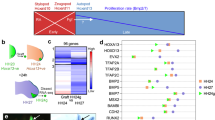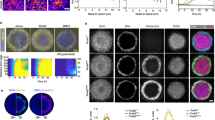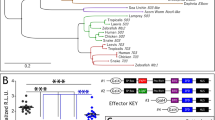Abstract
HENSEN'S node of amniotes, like the Spemann organizer of amphibians, can induce a second body axis when grafted into a host embryo1. The avian node, as well as several midline structures originating from it (notochord, floor plate), can also induce digit pattern duplications when grafted into the chick wing bud2,3. We report here that the equivalent of Hensen's node from mouse is an effective inducer of digits in the chick wing bud. Tissues anterior and posterior to the node also evoke pattern duplications, but with a significantly lower efficiency. The finding that the murine node operates in an avian wing bud suggests that the same inducing agent(s) function in both primary and secondary embryonic fields and have been conserved during vertebrate evolution. Digit pattern duplications are also evoked by local administration of all-trans-retinoic acid4,5. This similarity raises the possibility that Hensen's node is a source of retinoic acid. The mouse node is capable of synthesizing retinoic acid from its biosynthetic precursor all-trans-retinol at a substantially higher rate than either anterior or posterior tissues.
This is a preview of subscription content, access via your institution
Access options
Subscribe to this journal
Receive 51 print issues and online access
$199.00 per year
only $3.90 per issue
Buy this article
- Purchase on Springer Link
- Instant access to full article PDF
Prices may be subject to local taxes which are calculated during checkout
Similar content being viewed by others
References
Waddington, C. H. The Epigenetics of Birds (Cambridge Univ. Press, Cambridge, 1952).
Hornbruch, A. & Wolpert, L. J. Embryol. exp. Morph. 94, 257–265 (1986).
Wagner, M., Thaller, C. Jessell, T. & Eichele, G. Nature 345, 819–822 (1990).
Tickle, C. et al. Nature 296, 564–566 (1982).
Summerbell, D. J. Embryol. exp. Morph. 78, 269–289 (1983).
Eichele, G. Trends Genet. 5, 246–251 (1989).
Thaller, C. & Eichele, G. Nature 345, 815–819 (1990).
Thaller, C. & Eichele, G. Development 103, 473–483 (1988).
Ruberte, E., Dollé, P., Chambon, P. & Morriss-Kay, G. Development 111, 45–60 (1991).
Smith, S. M. & Eichele, G. Development 111, 245–252 (1991).
Rossant, J. et al. Genes Dev. 5, 1333–1344 (1991).
Durston, A. J. et al. Nature 340, 140–144 (1989).
Sive, H. L., Draper, B. W., Harland, R. M. & Weintraub, H. Genes Dev. 4, 932–942 (1990).
Ruiz i Altaba, A. & Jessell, T. Genes Dev. 5, 175–187 (1991).
Sharpe, C. R. Neuron 7, 239–247 (1991).
Kessel, M. & Gruss, P. Cell 67, 89–104 (1991).
Morriss-Kay, G. M., Murphy, P., Hill, R. E. & Davidson, D. R. EMBO J. 10, 2985–2995 (1991).
Sundin, O. H. & Eichele, G. Development 114, 841–852 (1992).
Conlon, R. A. & Rossant, J. Development (in the press).
Selleck, M. A. J. & Stern, C. D. Development 112, 615–626 (1991).
Schoenwolf, G. C., Garcia-Martinez, V. & Dias, M. S. Dev. Dynamics 193, 235–248 (1992).
Lawson, K. A. & Pedersen, R. A. in Post Implantation Development in the Mouse, Ciba Foundation Symp. 165 (eds Chadwick D. J. & Marsh, J.) 3–26 (Wiley, Chichester, 1992).
Stern, C. D. Anat. Embryol. 156, 319–329 (1979).
Simeone, A. et al. Nature 346, 763–766 (1990).
Simeone, A. et al. Mech. Dev. 33, 215–228 (1991).
Papalopulu, N., Lovell-Badge, R. & Krumlauf, R. Nucleic Acids Res. 19, 5497–5506 (1991).
Murphy, P. & Hill, R. E. Development 111, 61–74 (1991).
McGinnis W. & Krumlauf, R. Cell 68, 283–302 (1992).
Jessell, T. M. & Melton, D. A. Cell 68, 257–270 (1992).
Tickle, C., Summerbell, D. & Wolpert, L. Nature 254, 199–202 (1975).
Romijn, H. J. et al. Devl Brain Res. 2, 583–589 (1982).
Labarca, C. & Paigen, K. Analyt. Biochem. 102, 344–352 (1980).
Gaunt, S. J. & Singh P. B. Trends Genet. 6, 208–212 (1990).
Author information
Authors and Affiliations
Rights and permissions
About this article
Cite this article
Hogan, B., Thaller, C. & Eichele, G. Evidence that Hensen's node is a site of retinoic acid synthesis. Nature 359, 237–241 (1992). https://doi.org/10.1038/359237a0
Received:
Accepted:
Issue Date:
DOI: https://doi.org/10.1038/359237a0
This article is cited by
-
Acetaldehyde inhibits retinoic acid biosynthesis to mediate alcohol teratogenicity
Scientific Reports (2018)
-
Embryonic retinoic acid synthesis is essential for early mouse post-implantation development
Nature Genetics (1999)
-
A vital role for vitamin A
Nature Genetics (1999)
Comments
By submitting a comment you agree to abide by our Terms and Community Guidelines. If you find something abusive or that does not comply with our terms or guidelines please flag it as inappropriate.



